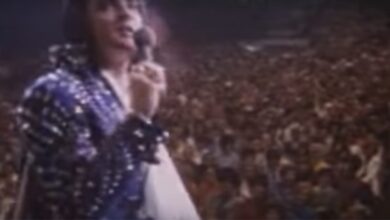Listening to Marty Haggard’s son sing his father’s song brings us to tears
“Mama’s Hungry Eyes” has carved a significant place in the annals of country music since its release. Originally penned and performed by Merle Haggard in 1968, the song serves as a heartfelt homage to the sacrifices made by his mother, a woman who faced considerable adversity following her husband’s death. As a young boy, Haggard witnessed firsthand the struggles of a single parent trying to forge a life for her children against overwhelming odds. The depth of emotion captured in “Mama’s Hungry Eyes” reflects those experiences, making it a universally relatable work that resonates with many who have faced similar familial challenges.
The song’s lyrics poignantly describe a world of hardship and resilience. The imagery in the song paints a vivid picture of the struggles faced by Haggard’s mother, casting her as a figure of strength and determination. The portrayal of a mother working tirelessly to provide for her children epitomizes the themes typical of country music, where storytelling often intertwines with personal experiences. With each verse, Haggard weaves a narrative that reveals not just the struggles, but also the profound love his mother had for her family, marking the song as an emotional cornerstone in his repertoire.
Musically, “Mama’s Hungry Eyes” features a simple yet poignant melody that complements its heartfelt lyrics. Haggard’s signature voice, characterized by its rich timbre and emotional clarity, lends additional weight to the song’s narrative. The arrangement reflects a classic country sound, where the focus remains on the storytelling aspect, allowing the listener to connect deeply with the message conveyed. This combination of lyrical sincerity and melodic simplicity contributes significantly to the song’s lasting legacy within the genre.
Marty Haggard, Merle’s son, recognized the significance of “Mama’s Hungry Eyes” and chose to honor his father’s work through his own rendition. Released years later, Marty’s version not only preserves the emotional essence of the original but also introduces new elements that amplify the narrative. His fresh perspective is rooted in a desire to give voice to his mother’s struggles, bringing to light specific details about her life that may not have been fully explored in the original. This generational connection adds layers of depth to the song, as it reflects an ongoing tribute to the family’s legacy.
In his adaptation, Marty includes a new verse detailing his mother’s hard work at a truck stop, highlighting her tireless efforts to maintain a sense of normalcy for her children. This additional context allows listeners to appreciate more fully the breadth of sacrifice made by Haggard’s mother, providing a deeper understanding of the social realities faced by those in similar circumstances. By infusing his version with personal touches and additional lyrics, Marty Haggard successfully expands the narrative while honoring his father’s artistic contributions.
The widespread appeal of “Mama’s Hungry Eyes” speaks to its remarkable ability to evoke deep feelings of empathy and connection among listeners. The song resonates particularly with those who have experienced hardship or who hold respect for the sacrifices made by their parents. It encapsulates the essence of country music’s storytelling tradition, where every note and word feels like a shared memory or a collective experience. This connection to personal and familial narratives allows the song to transcend generations, maintaining its relevance as new listeners discover its profound message.
As the years have passed, “Mama’s Hungry Eyes” has become a staple in the country music genre. It not only showcases the artistry of both Merle and Marty Haggard but also serves as an enduring reminder of the power of family narratives. The song’s legacy continues to influence aspiring artists who draw inspiration from its honest portrayal of love and sacrifice. Within the larger context of country music, “Mama’s Hungry Eyes” stands as an emblematic representation of the genre’s roots in storytelling, embodying themes that resonate universally across diverse audiences.
Merle Haggard’s career was defined by his ability to capture the essence of American life through his songwriting. Born in 1937 in Oildale, California, he experienced a tumultuous upbringing that influenced his musical journey. Haggard’s music often reflected his personal experiences, including his early life filled with hardship, run-ins with the law, and eventual redemption through music. He became one of the most influential figures in country music, earning a place in the Grand Ole Opry and winning numerous awards throughout his career.
Marty Haggard, following in his father’s footsteps, emerged as a performer with his own distinct voice and style while carrying the torch of his family’s musical legacy. He has carved out his own niche in the industry, paying tribute to both his father’s classics and contributing original works to the genre. The connection between the two Haggards showcases not only the importance of familial bonds in the world of music but highlights how narratives can evolve and enrich through generations.
In conclusion, “Mama’s Hungry Eyes” remains a poignant piece of musical art that resonates long after its original release. Its themes of sacrifice, love, and resilience echo through its timeless melody and heartfelt lyrics. By bridging the gap between generations, the song stands as a vital part of the Haggard family legacy while also encouraging listeners to reflect on their own familial experiences. The ability of the Haggard family to transform personal pain into beautiful music is a testament to the enduring power of storytelling in country music—a power that continues to inspire and connect people from all walks of life.





